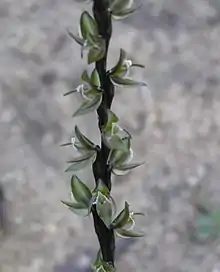Prasophyllum triangulare
Prasophyllum triangulare, commonly known as the dark leek orchid, is a species of orchid endemic to the south-west of Western Australia. It is a tall orchid with a single, purplish to blackish, tubular leaf and up to thirty or more relatively large, greyish-purple to brownish-purple flowers. It only flowers after fire the previous summer.
| Dark leek orchid | |
|---|---|
 | |
| Prasophyllum triangulare growing near Kukerin | |
| Scientific classification | |
| Kingdom: | Plantae |
| Clade: | Tracheophytes |
| Clade: | Angiosperms |
| Clade: | Monocots |
| Order: | Asparagales |
| Family: | Orchidaceae |
| Subfamily: | Orchidoideae |
| Tribe: | Diurideae |
| Subtribe: | Prasophyllinae |
| Genus: | Prasophyllum |
| Species: | P. triangulare |
| Binomial name | |
| Prasophyllum triangulare | |
Description
Prasophyllum triangulare is a terrestrial, perennial, deciduous, herb with an underground tuber and a single fleshy, purplish to blackish, tube-shaped leaf 250–350 mm (9.8–14 in) long and 2–5 mm (0.08–0.2 in) wide. Between ten and thirty or more flowers are arranged along a flowering spike 90–180 mm (4–7 in) long, reaching to a height of 300–400 mm (10–20 in). The flowers are greyish-purple to brownish-purple, about 12 mm (0.5 in) long and about 9 mm (0.4 in) wide. As with others in the genus, the flowers are inverted so that the labellum is above the column rather than below it. The dorsal sepal is 6–7 mm (0.2–0.3 in) long and about 2 mm (0.08 in) wide and the lateral sepals are a similar size and fused to each other. The petals are 5–6 mm (0.20–0.24 in) long, 2 mm (0.08 in) wide and turn forwards. The labellum is 8–9 mm (0.3–0.4 in) long, about 5 mm (0.2 in) wide and turns sharply upwards near its middle, the upturned part with slightly wavy edges. A broad callus covers most of the labellum, reaching almost to its tip. Flowering occurs in September and October but only following summer fire.[2][3][4]
Taxonomy and naming
Prasophyllum triangulare was first formally described in 1882 by Robert D. FitzGerald and the description was published in The Gardeners' Chronicle.[1][5] The specific epithet (triangulare) is derived from a Latin word triangulus meaning "triangular"[6] referring to the narrow, triangular shape of the labellum.[3]
Distribution and habitat
The dark leek orchid grows in shrubland, woodland and forest between Augusta and Albany in the Avon Wheatbelt, Esperance Plains, Jarrah Forest and Warren biogeographic regions.[2][3][4][7]
Conservation
Prasophyllum regium is listed as "Not Threatened" by the Western Australian Government Department of Parks and Wildlife.[7]
References
- "Prasophyllum triangulare". APNI. Retrieved 1 January 2018.
- Hoffman, Noel; Brown, Andrew (2011). Orchids of South-West Australia (3rd ed.). Gooseberry Hill: Noel Hoffman. p. 379. ISBN 9780646562322.
- Brown, Andrew; Dundas, Pat; Dixon, Kingsley; Hopper, Stephen (2008). Orchids of Western Australia. Crawley, Western Australia: University of Western Australia Press. p. 337. ISBN 9780980296457.
- Jones, David L. (2006). A complete guide to native orchids of Australia including the island territories. Frenchs Forest, N.S.W.: New Holland. p. 196. ISBN 1877069124.
- Fitzgerald, Robert D. (1882). "New Australian orchids". The Gardeners' Chronicle. 17: 495. Retrieved 1 January 2018.
- Brown, Roland Wilbur (1956). The Composition of Scientific Words. Washington, D.C.: Smithsonian Institution Press. p. 813.
- "Prasophyllum triangulare". FloraBase. Western Australian Government Department of Parks and Wildlife.
External links
 Data related to Prasophyllum triangulare at Wikispecies
Data related to Prasophyllum triangulare at Wikispecies Media related to Prasophyllum triangulare at Wikimedia Commons
Media related to Prasophyllum triangulare at Wikimedia Commons
